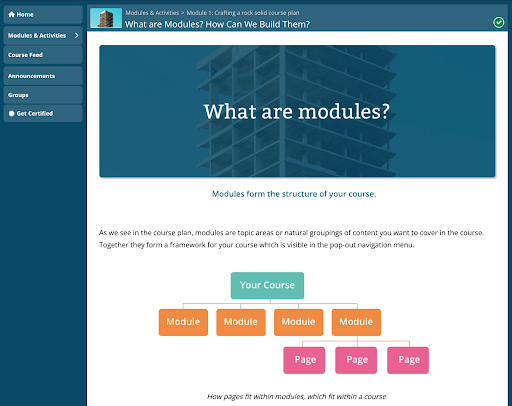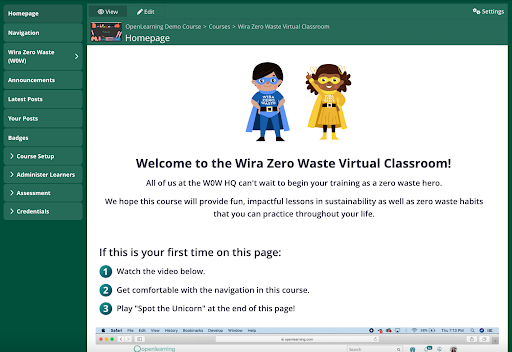The rise in popularity of online learning is attributed to its flexibility and accessibility for individuals of all ages, be they students or professionals. The convenience of learning anytime, anywhere is a major draw.
However, the true test lies in maintaining learners' interest past the 'Join Now' button. This blog post delves into strategies to enhance engagement and make online courses more compelling for students.
One effective strategy to make online learning activities more engaging is to get social and build rapport among learners.
Online learning can sometimes feel isolating, especially in self-paced courses where learners are accessing the course at different times. So, it's important to create opportunities for learners to connect asynchronously with each other and the facilitator.
Social learning strategies are key in this context:
👉 Download whitepaper: The 5 pillars of social learning: co-creation, crowdsourcing, managing collaboration, social presencing, and self-expression.
Empowering learners through the principles of social constructivism can greatly enhance engagement in online learning activities. Social constructivism emphasizes the importance of collaboration, discussion, and active participation in the learning process.
By incorporating group projects, online discussions, and collaborative problem-solving activities, students are able to construct their own knowledge and make connections with their peers. This not only enhances engagement but also fosters critical thinking and deeper understanding of the subject matter.
Another effective strategy to enhance engagement in your online course is to use visual elements that are tailored to the target audience. Visuals can help convey information more effectively and make the learning experience more interesting.
For example, you can use infographics, videos, or interactive content to present complex concepts in a more visually appealing way. This not only helps to capture learners' attention but also aids in their understanding and retention of the material.
When it comes to engaging with adults and kids in online learning activities, it's essential to tailor the visuals to the specific target audience. For adults, incorporating sleek and professional visuals like flowcharts can help convey complex concepts effectively.

A course on online course design that explains the structure of a course by breaking it down into a flowchart.
On the other hand, for younger learners, consider using colourful and interactive visuals that spark creativity and curiosity:

A course on sustainability for 11-year-old learners that introduces superhero mascots throughout the learning journey.
By tailoring visuals to the target audience, educators can create a more personalised and impactful learning experience. Use visual elements that resonate with the specific audience to make online courses more engaging and effective in facilitating learning.
▶️ Watch: Free online teaching tools and resources to beautify your course.
A welcoming introduction activity is a great way to kick off online learning activities and set a positive tone for the course. This can be done through a variety of methods, such as icebreaker activities, virtual introductions, or creating an online discussion board where students can share their interests and goals.
By creating a welcoming and inclusive environment from the start, students are more likely to feel comfortable and engaged throughout the course.
The OpenLearning AI Assistant provides several icebreaker activity styles, such as:
⭐️ More activity ideas: 3 Fun Icebreaker Activities for Your Online Course.
To ensure maximum engagement in online learning activities, it's important to keep the content simple and easy to navigate. This can be achieved through the use of chunking, which involves breaking down large amounts of information into smaller, more manageable sections.
▶️ Watch: Here's how this educator keeps his online courses simple.
By organising the content into easily digestible chunks, learners are less likely to feel overwhelmed and more likely to stay engaged.
Additionally, providing clear and intuitive navigation within the online learning platform can help learners easily find and access the information they need.
🆓 Free template: Add your course branding to this navigation guide on Canva.
Adding variety to online learning activities is key to keeping learners engaged. One way to achieve this is through the incorporation of multimodal activities, which involve using multiple forms of media and resources to deliver content.
For example, you can include a combination of text-based articles, videos, interactive content, and hands-on projects. This not only caters to different learning styles but also keeps the learning experience dynamic and engaging.
The OpenLearning AI Assistant offers a range of activity styles and content styles that you can use to deliver multimodal learning experiences, such as:
✨ Try it now: Explore our growing list of activity styles and content styles in the OpenLearning AI Assistant.
In conclusion, enhancing engagement in online learning activities involves fostering social connections, using visual elements tailored to the target audience, creating welcoming introductions, keeping content simple and navigable, and incorporating a variety of multimodal activities.
By implementing these strategies, educators can create a more interactive and effective online learning experience. To further explore and implement these engagement techniques in your own online courses, consider delving deeper into each strategy and experimenting with different approaches. Remember, the key to successful online learning lies in keeping learners engaged and motivated throughout their educational journey.
A: Enhance your online course with interactive tools like discussion forums, quizzing platforms (e.g. Kahoot!), VR/AR simulations, whiteboards, video conferencing, gamification, interactive presentations (e.g. Mentimeter, H5P, Genially), collaborative document editing (e.g. Google Docs), and online collaboration tools (e.g. Slack). These technologies promote engagement, collaboration, and hands-on learning experiences for students in virtual classrooms. Many of these tools can be embedded into the OpenLearning platform.
A: Best practices for visually appealing online courses include maintaining a consistent design, using enough white space, employing a clear visual hierarchy, incorporating high-quality images and graphics, selecting readable fonts, ensuring accessibility, adding interactive elements, and iterating based on learner feedback for continuous improvement.
A: Educators can deliver effective icebreaker activities by selecting inclusive and non-threatening prompts, fostering positive interactions among learners, encouraging active participation from all individuals, respecting diverse perspectives and backgrounds, creating a supportive atmosphere, and demonstrating genuine interest in getting to know each student.
A: Chunking techniques for simplifying online course content include breaking down material into smaller, manageable sections, organising content by topics or themes, using bullet points and numbered lists to highlight key points, incorporating headings and subheadings for clarity, and using multimedia elements to reinforce learning in bite-sized chunks.
A: Educators can effectively incorporate multimodal activities by recognising that individuals learn best through exposure to various learning modalities. By providing a range of learning materials such as videos, podcasts, written texts, and interactive simulations, educators cater to the diverse preferences and strengths of learners, fostering engagement and deeper understanding.
A: Yes, AI can streamline course development by automating tasks such as content creation, analysis of learner data, personalisation of learning experiences, and feedback. It can also assist in identifying areas for improvement and optimising course design based on learner interactions and outcomes.
